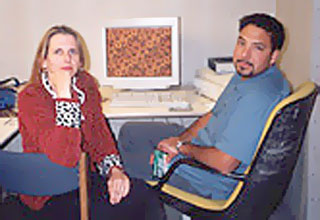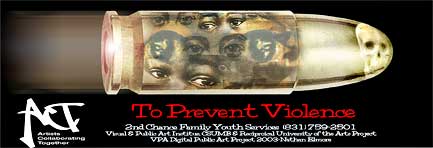|
An assistant
professor of replicative media in the Institute for Visual and Public
Art, Gilbert Neri has an undergraduate degree from UC-San Diego and
an M.A. from UC-Santa Barbara. He joined CSUMB in the fall of 2001,
drawn by the power of the university’s Vision Statement as well
as VPA’s socially conscious approach to art making. |

VPA Professors Johanna Poethig and Gilbert Neri
|
Along
with Johanna Poethig, Gilbert teaches the large-scale digital public
art class. In this class students learn digital art through a content-based,
community collaborative practice. In the 2002-2003 school year, the
class collaborated with the Second Chance Youth Program in Salinas to
develop a series of billboards, signs and posters with anti-gang, anti-youth
violence messages.
Joan Weiner, RUAP coordinator, interviewed Gilbert. |
JW:
What is the objective of the digital art class? Tell me a little about
the principles that shape this class. How does it fit in with the VPA
vision?
GN: The objectives in the large-scale digital mural class are many, but
among the most important are creating public artwork in a true collaboration
with our community partner as well as examining the role of the artist
in the community.
One of the driving principles behind the class is the bridging of longstanding
gaps between the university and the communities for which it exists. Through
RUAP, community relationships are not only established for the particular
project we are working on in a given year, but are also maintained and
allowed a space to grow for future collaborations and other creative projects.
Another of the guiding principles/goals in this class is the investigation
of the role of the artist in community-based projects, and also the role
of authorship in these projects. It allows students, in many ways, to
exercise creativity and also to activate that creativity as a form of
social agency rather than as an outside entity, coming into it with pre-formed
ideas about what matters to this community. This, I think, is one of the
essential threads in the broader weave of VPA. It conceptualizes creative
practice in the broader matrix of culture, history and the impact that
creativity can have in envisioning a future as such. |
JW:
How was the decision made to integrate the class with RUAP? A RUAP community
partner has worked with the VPA 306 class each year – Watsonville
Community School, Monterey County AIDS Project, the Monterey Museum
of Art, Second Chance. VPA 306 is an integral part of RUAP, and in some
ways, the backbone of it. How did this come about? |
|
GN: RUAP was envisioned by Amalia Mesa-Bains and Richard Bains as a way
in which to change the ivory tower position many universities hold around
the nation. RUAP allows us to work with community organizations in a more
substantial way than simply a one-time event. The Reciprocal University
for the Arts Project has successfully created an environment and means
through which the Institutes for Visual and Public Art and Music and Performing
Arts collaborate with the local communities on creative projects.
The large-scale digital mural course addresses the complex process of
creating and exhibiting public art. In this case the artwork is primarily
digitally created, but the underlying tenets of public art issues are
always present. RUAP works in tandem with this class as support and liaison
to our community partner. RUAP establishes the partnership, and then our
class continues the partnership through collaborative public art production. |
JW:
Can you describe the interaction you observe between your students and
the Second Chance youngsters?
GN: Before we meet our community partner members, Johanna Poethig and
I have students read about and discuss the broader social and cultural
issues that might impact our community partner. In other words, we attempt
to build a collective understanding of our own preconceptions, as well
as an understanding that we can bring to the table. It is very necessary
background work needed to express the respect for a group or community
one may not know much about. It is a way of digging deeper into the issues
and details that our community partner might grapple with on a day-to-day
basis, and also give us insights into the value of the work that they
do.
The interaction between our class and the youth from Second Chance was
one that continually evolved. At first, of course, we were all getting
to know one another, and also collectively crafting what we wanted to
do. As a class, we do not dictate what the project will be. This is created
only when the community partner’s members arrive. It gives the youth
a place for their own voice to be heard and allows them to really own
and invest in the project.
So over the year, the relationships we built with the youth grew, and
as confidence grew, so, too, did the process of the project. |
JW:
What do your students get out of the collaboration with community partners?
In what ways did the class challenge the students by having to work collaboratively?
GN: I think each student takes something different away form the class,
especially because we all bring quite different life stories to the table.
I think, though, that one of the challenges that the class poses is to
bring into question the traditional notion of the artist-as-sole-creator.
The project we create belongs to no one and everyone at once. I think
it is a challenge that most of our students meet with enthusiasm.
Another challenge is posed by students having to contact a local business
for exhibition space. This was true of our class last year where we collaborated
with the Monterey Museum of Art. I think the most significant thing here
is that you are really putting yourself in a position where you are an
advocate, community member, artist and collaborator all at once. It is
a generous and vulnerable place to work from, but ultimately very rewarding.
Johanna and I share every part of the process of contacting community
members, organizing meetings, and dealing with the money issues involved
in creating our project. Every part of the process is front and center;
decisions are made by the class and our community partners. So there are
many ways the class offers up collaborative challenges. |
| JW:
How does the experience impact the Second Chance youngsters? Do you see
changes in their attitudes, perceptions, participation level, etc., over
the course of the semester? |
|
GN:
Again, our youth come from such diverse circumstances that it is hard
to tell what impact it might have, but there are some visible changes,
which are always great to see. This year one of our youth went on to record
some hip-hop music and take part in a project called “Transmissions”
which was a sound/art event that took place in Salinas. I think he, most
visibly, has such confidence, and I think he was able to see his creative
work as something that others would engage with.
Two of the three youth from the first semester were incarcerated before
the end of the semester. After they were released, they had no obligation
to return to the class, but did so because they were really into what
we were doing. This was great to see, and they were such a powerful and
guiding force in the way the project developed. |
JW:
If it weren’t for RUAP, how would the class be different? Is having
a community partner essential to the mission of VPA 306?
GN: Definitely. Without RUAP operating as support and liaison to the community,
VPA 306 would be a large-scale digital art class that is probably like
any other digital art class. You cannot teach the creation of public art
in as comprehensive a way without a direct and sustained connection to
the community you are a part of. RUAP allows the class to take on the
creative aspect of the work, but also make visible the often invisible
work it takes to create and maintain community partnerships that are reciprocal
and lasting. |
 |




